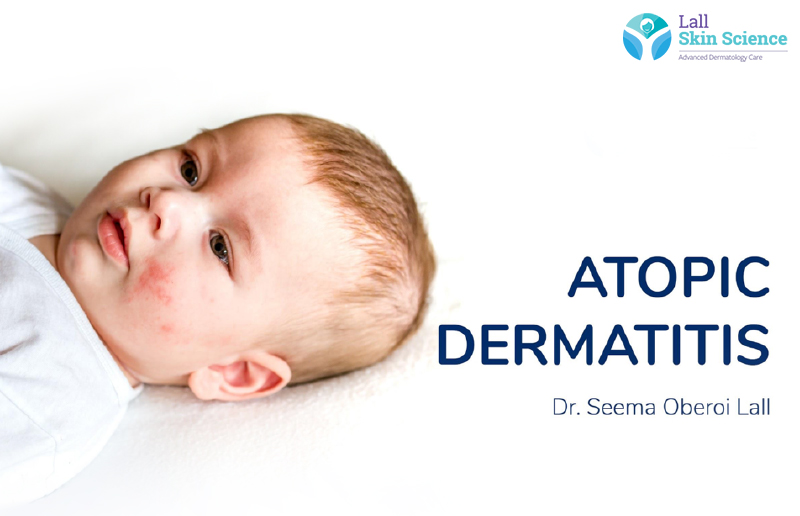A Baby’s skin is precious but sometimes it can get red and itchy especially in dry winters. In such situations, DO NOT PANIC!
This might be Atopic Dermatitis – a very common form of Eczema in children. In simple terms ‘Atopy’ is a tendency to develop allergies (skin, nose, lungs or even digestive tract) and ‘Dermatitis’ is inflammation of skin. It can happen at any age, but is more common among babies and children. About 7 to 17% of children may have it in some form or the other. Children up to the age of 12 years are more prone to Atopic Dermatitis.
The areas on body that are mainly affected are cheeks, outer side of arms and legs in infants, while skin folds of the neck, armpits, wrists, ankles, behind elbows and knees in slightly older children and adults.
The most common symptoms of Atopic Dermatitis are extremely dry & itchy skin. Apart from this, patches and small bumps with oozing fluids may appear, ranging from red to brown in colour. This can form cracks and crusts on the skin, which increases scratching and makes the skin look raw, rough and sensitive.
The exact cause of Atopic Dermatitis is still being researched, but genetic and environmental factors are the main triggers. Children who have family members with allergies are more prone to be affected by this skin condition. The other triggers are:
- Dryness – Changes in weather reduces moisture in the air, making the skin dry and prone to this condition.
- Prolonged hours of bathing can dehydrate the skin.
- Contact with substances like wool, dust, harsh chemicals, such as Dettol, Savlon, detergents, soaps, mustard oil, etc. also aggravate the condition.
- Sudden change of temperature and sweating can induce itching.
- Things like house dust/pollen/fur of pets settle on the skin and trigger allergies.
- Emotional stress is also a major factor.
- Food like eggs, peanuts, milk, soy and wheat are also a trigger for Atopic Dermatitis. Consult your doctor for a way to find out which food item is causing allergy.
One must visit a doctor if the child’s skin is extremely dry and has bumps with pus, scabs or red streaks.Treatment for Atopic Dermatitis depends on the severity of the condition. In few of the cases, some simple home-remedies work wonders, but in acute cases, treatment could range from wet wipes to topical and oral medications. One should consult a doctor for best treatment and follow as prescribed.
A few practical tips carried out at home can go a long way to help ease irritation on your child’s skin. Get all the products approved by your doctor before applying them on the baby’s skin.
- Moisturizing your child’s skin will keep it well hydrated. Apply coconut oil an hour before bathing. After bath, apply a good heavy duty moisturizer evenly and use it as frequently as needed during the day.
- Avoid hot water for bath, as it will steal away all the natural oils from the body. Use a good non soapy oil based cleanser. Add 2 caps of Emollient or 10-12 drops of coconut oil in half a bucket as a last rinse.
- In summers, dress your child in pure cotton clothes. During winters, I recommend using the ‘Sandwich Method’ – Make your child wear woolen clothes between 2 layers of cotton clothing, to avoid itching.
- Always wash new clothes before using, but avoid rinsing them in Dettol etc.
- Do not use products with harsh chemicals like powders/Dettol/ Savlon/Medimix/Lifebuoy etc. on your child’s skin.
- Do not make your child wear any kind of jewellery, as the metals may sensitize the skin causing further irritation.
- Always keep your surroundings clean from dust as much as possible.
- Avoid stuffed toys with fur on them and use washable ones instead.
- Avoid using thick bed sheets, thick curtains and feather pillows, as these tend to trap dust.
- Clean your baby’s face after feeding them, to avoid Facial Eczema.
- Exclusive breast-feeding during the first 6 months of life helps protect a baby from Atopic Dermatitis. Also avoid introducing solids during the first 6 months of an infant’s life.
Atopic Dermatitis is quite common amongst children, who pass through this phase and grow up healthy. It just needs to be recognised early and given necessary and adequate care. Only 10-15% of such cases move into the adult phase. So, moisturise, follow precautions, and seek treatment at an early stage, if any rashes appear. Following these steps will ensure that Atopic Dermatitis does not hamper your child’s happiness in any way.
Consult Dr. Seema Oberoi Lall, Lall Hospital, for any Skin related Consultation.

